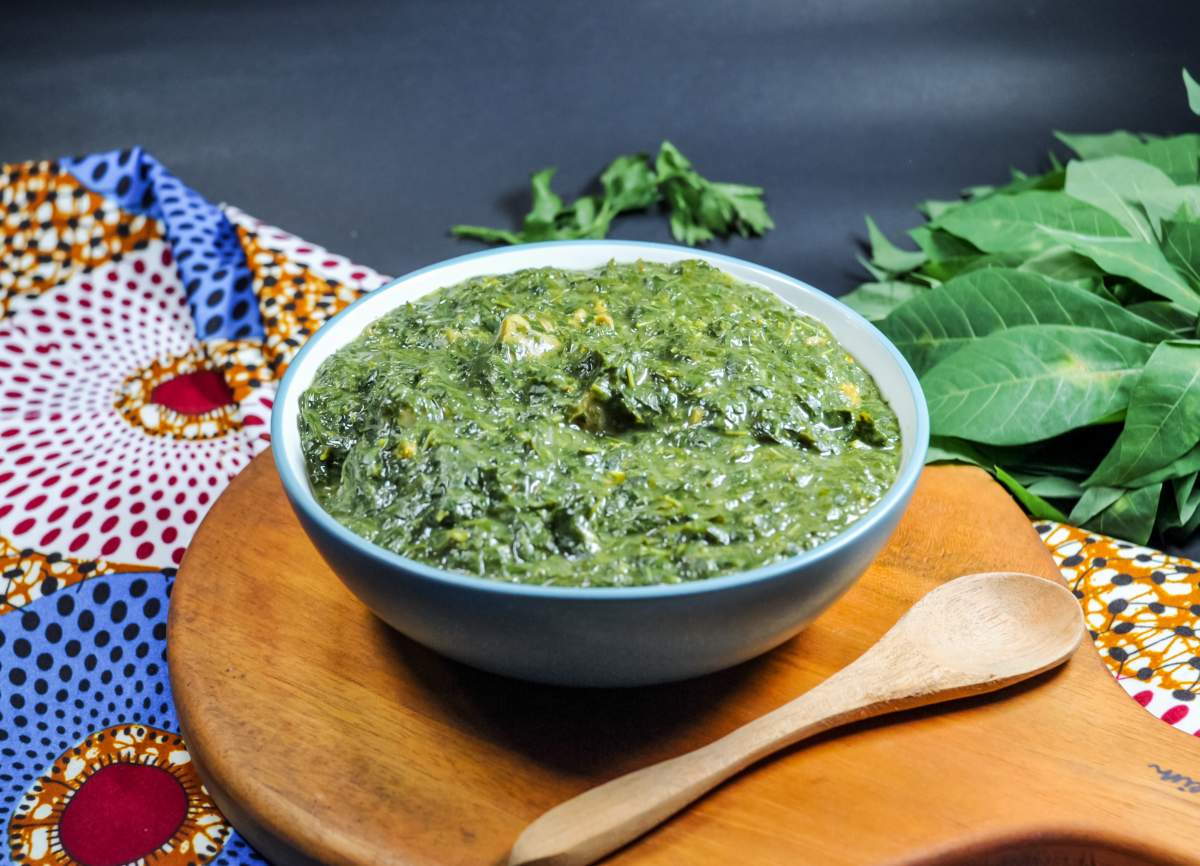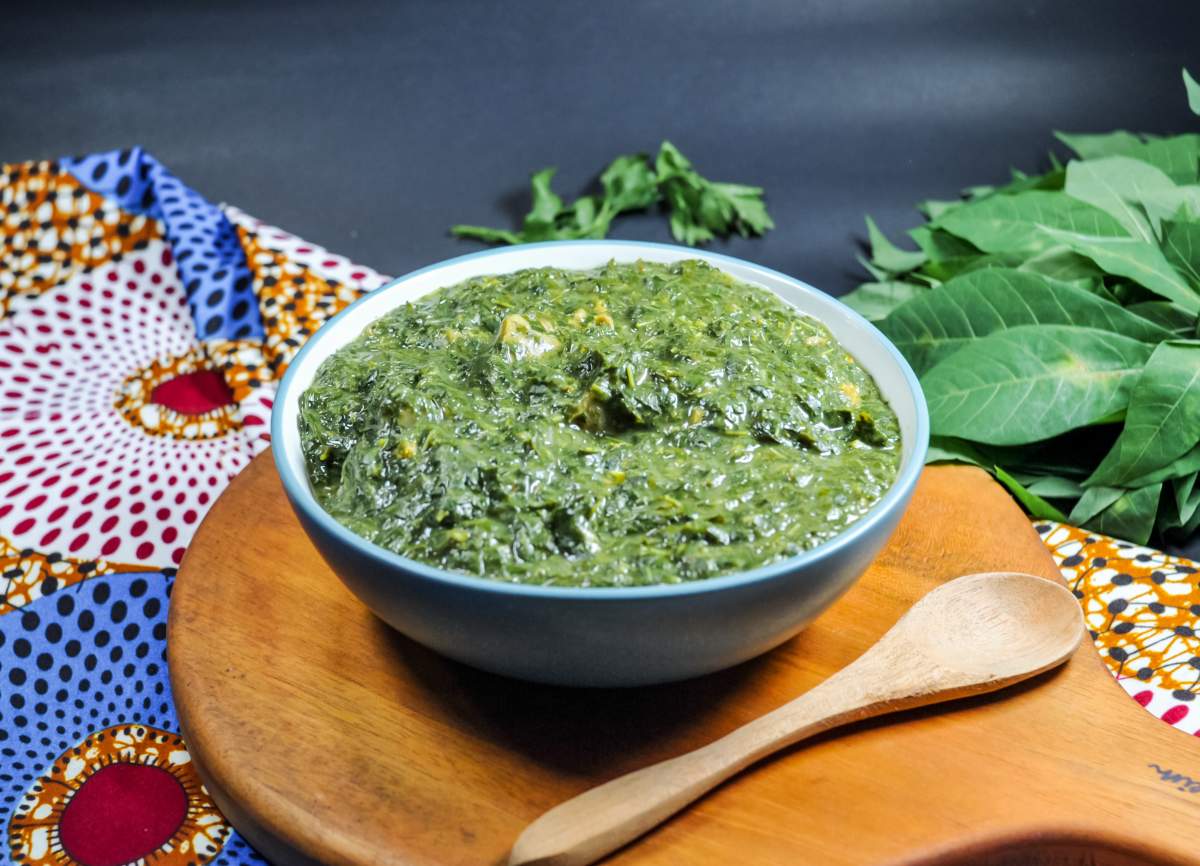How to Create Nutritious Meals with Cassava Leaf: Essential Recipes and Cooking Advice – Cassava leaves, a vibrant green staple in many cultures, are not only delicious but also a powerhouse of nutrients. This versatile ingredient can be transformed into a variety of flavorful dishes, from traditional African stews to modern stir-fries and soups.
This comprehensive guide will delve into the world of cassava leaves, exploring their nutritional benefits, providing essential preparation tips, and showcasing a range of enticing recipes.
Beyond their nutritional value, cassava leaves offer a unique flavor profile that can be adapted to suit diverse culinary preferences. From the subtle bitterness that can be tamed with proper preparation to the earthy notes that lend themselves to rich sauces, cassava leaves are a culinary canvas waiting to be explored.
This guide will empower you to confidently incorporate cassava leaves into your cooking repertoire, unlocking a world of delicious and healthy meals.
Introduction to Cassava Leaf
Cassava leaf, also known as cassava greens or Manihot esculenta, is a highly nutritious and versatile leafy green vegetable that has been a staple food source in many tropical and subtropical regions for centuries. It is a rich source of essential vitamins, minerals, and antioxidants, making it a valuable addition to a healthy diet.
Cassava leaf is an excellent source of vitamin A, vitamin C, iron, calcium, and protein. It is also a good source of dietary fiber, which is important for digestive health. The leaves are commonly used in various cuisines around the world, adding a unique flavor and texture to dishes.
They can be cooked in a variety of ways, including steaming, boiling, stir-frying, and making soups and stews.
Choosing Fresh, High-Quality Cassava Leaves
It is crucial to choose fresh, high-quality cassava leaves for optimal flavor, nutritional value, and safety. Here are some key points to consider when selecting cassava leaves:
- Look for bright green leaves:Fresh cassava leaves should have a vibrant, bright green color. Avoid leaves that are wilted, yellowed, or discolored, as these may indicate spoilage.
- Check for crispness:The leaves should be firm and crisp to the touch. Avoid leaves that are soft or limp, as these may be old or damaged.
- Inspect for pests:Carefully examine the leaves for any signs of insects or other pests. If you notice any pests, it is best to choose a different bunch of leaves.
- Consider the origin:If possible, choose cassava leaves that are locally grown and sourced from reputable farms. This helps ensure that the leaves are fresh and have not been treated with harmful chemicals.
Preparing Cassava Leaves for Cooking
Cassava leaves, a nutritious and versatile ingredient, require proper preparation before they can be cooked into delicious meals. This process involves cleaning, removing bitterness, and blanching or steaming the leaves to ensure a safe and palatable final product.
Cleaning Cassava Leaves
Cleaning cassava leaves thoroughly is essential to remove dirt, insects, and any other debris that may be present. This step is crucial for ensuring food safety and preventing any unpleasant surprises in your final dish.
- Start by rinsing the cassava leaves under cold running water. This helps to remove any loose dirt or debris.
- Next, inspect the leaves carefully, removing any damaged or discolored parts. This ensures that only fresh and healthy leaves are used in your dish.
- If you are using fresh cassava leaves, you may need to trim the stems. Cut off the tough stems and use only the tender leaves for cooking. This ensures that the leaves are easy to chew and digest.
- Finally, soak the cleaned cassava leaves in a bowl of clean water for about 15 minutes. This helps to remove any remaining dirt or insects. Drain the leaves thoroughly before proceeding with the next step.
Removing Bitterness from Cassava Leaves
Cassava leaves naturally contain a slightly bitter compound called hydrocyanic acid. While this compound is generally present in low levels, it can be removed by blanching or steaming the leaves. This process helps to break down the bitter compound and enhance the flavor of the leaves.
Learning to cook with cassava leaves can be a rewarding culinary journey, offering a wealth of nutritional benefits and a unique flavor profile. Just as growing your own roses can save you money, learning to propagate them from cuttings can provide you with a continuous supply of these beautiful blooms.
Never Buy Roses Again: How To Propagate Roses From Cuttings and Save Money! Similarly, mastering cassava leaf recipes can help you enjoy a delicious and nutritious meal without breaking the bank.
Blanching Cassava Leaves
Blanching is a quick cooking method that involves immersing the leaves in boiling water for a short period. This helps to soften the leaves, remove bitterness, and retain their vibrant green color.
- Bring a large pot of water to a rolling boil. Add a teaspoon of salt to the boiling water. Salt helps to preserve the color of the leaves.
- Carefully add the cleaned cassava leaves to the boiling water. Ensure that the leaves are fully submerged in the water.
- Blanch the leaves for about 3-5 minutes, depending on their thickness. The leaves should turn bright green and become slightly tender. Avoid over-blanching, as this can make the leaves mushy.
- Remove the blanched leaves from the boiling water using a slotted spoon or strainer. Immediately plunge them into a bowl of ice water to stop the cooking process and preserve their color.
- Drain the leaves thoroughly and pat them dry with a clean kitchen towel before using them in your recipe.
Steaming Cassava Leaves
Steaming is another effective method for removing bitterness and softening cassava leaves. This method is gentler than blanching and helps to retain the leaves’ natural flavor and nutrients.
- Fill a steamer basket with the cleaned cassava leaves. Ensure that the leaves are not overcrowded in the basket.
- Place the steamer basket over a pot of boiling water. Make sure that the water does not touch the leaves.
- Steam the leaves for about 10-15 minutes, depending on their thickness. The leaves should turn bright green and become tender.
- Remove the steamed leaves from the steamer basket and set them aside to cool slightly before using them in your recipe.
Essential Cassava Leaf Recipes
Cassava leaves, a versatile and nutritious ingredient, offer a wide range of culinary possibilities. From traditional African dishes to Asian-inspired stir-fries and Western-style soups and stews, cassava leaves can be incorporated into various cuisines, adding a unique flavor and texture to your meals.
Cassava Leaf Recipes
Here are some delicious and nutritious recipes that showcase the versatility of cassava leaves:
Recipe Name |
Ingredients |
Instructions |
Serving Suggestions |
|---|---|---|---|
Egusi Soup with Cassava Leaves |
|
|
|
Cassava Leaf Stir-Fry |
|
|
|
Cassava Leaf Soup |
|
|
|
Cassava Leaf and Peanut Stew |
|
|
|
Cooking Techniques for Cassava Leaves
Cassava leaves are a versatile ingredient that can be cooked using a variety of methods, each resulting in a unique texture and flavor profile. Choosing the right cooking technique depends on the desired outcome and the specific recipe you are preparing.
This section will explore some common cooking methods for cassava leaves and provide tips for achieving the desired texture and flavor.
Sautéing
Sautéing is a quick and easy way to cook cassava leaves, resulting in a tender and slightly crisp texture. This method is ideal for stir-fries, soups, and stews.To sauté cassava leaves, heat a pan with oil over medium heat. Add the leaves and cook for 3-5 minutes, stirring occasionally, until they are wilted and slightly browned.
Season with salt, pepper, and other desired spices.
Tips for Sautéing Cassava Leaves:
- Use a pan with a wide surface area to allow for even cooking.
- Avoid overcrowding the pan, as this can cause the leaves to steam instead of sauté.
- Add a splash of water or broth to the pan if the leaves start to stick.
- Sautéing cassava leaves in a small amount of oil can create a more intense flavor.
Steaming
Steaming is a gentle cooking method that preserves the nutrients and flavor of cassava leaves. This method results in a tender and slightly chewy texture.To steam cassava leaves, place them in a steamer basket over boiling water. Cover the pot and steam for 5-10 minutes, or until the leaves are tender.
Season with salt, pepper, and other desired spices.
Tips for Steaming Cassava Leaves:
- Use a steamer basket that fits snugly in the pot to prevent the leaves from falling into the water.
- Add a few drops of lemon juice to the water to brighten the flavor of the leaves.
- Do not overcook the leaves, as this can make them mushy.
- Steaming cassava leaves can be combined with other cooking methods, such as sautéing or stir-frying, for added flavor and texture.
Boiling
Boiling is a simple and straightforward way to cook cassava leaves, resulting in a soft and tender texture. This method is often used for soups, stews, and other dishes where the leaves are cooked until they are very soft.To boil cassava leaves, bring a pot of water to a boil.
Add the leaves and cook for 5-10 minutes, or until they are tender. Season with salt, pepper, and other desired spices.
Tips for Boiling Cassava Leaves:
- Use a large pot to prevent the leaves from overcrowding.
- Add a pinch of salt to the boiling water to enhance the flavor of the leaves.
- Do not overcook the leaves, as this can make them mushy.
- Boiled cassava leaves can be used in a variety of dishes, such as soups, stews, and salads.
Stir-Frying
Stir-frying is a quick and flavorful way to cook cassava leaves, resulting in a tender and slightly crisp texture. This method is ideal for stir-fries, noodles, and other dishes where the leaves are cooked with other ingredients.To stir-fry cassava leaves, heat a wok or large skillet with oil over high heat.
Add the leaves and cook for 2-3 minutes, stirring constantly, until they are wilted and slightly browned. Add other ingredients, such as meat, vegetables, and spices, and continue to stir-fry until everything is cooked through.
Tips for Stir-Frying Cassava Leaves:
- Use a wok or large skillet with high sides to prevent the ingredients from splattering.
- Heat the oil until it is very hot before adding the leaves.
- Stir-fry the leaves quickly and constantly to prevent them from sticking to the pan.
- Add a splash of water or broth to the pan if the leaves start to stick.
Flavor Combinations and Garnishes

Cassava leaves, while nutritious, have a mild, slightly bitter flavor that can benefit from the addition of spices, herbs, and other ingredients to enhance their taste and create a more flavorful and appealing dish. This section will explore ways to elevate the flavor of cassava leaf dishes through various flavor combinations and garnishes.
Learning how to incorporate cassava leaves into your diet can unlock a world of nutritious and delicious possibilities. From stir-fries to soups, cassava leaves offer a unique flavor profile and a wealth of vitamins and minerals. While you’re focusing on healthy eating, remember to take care of your outdoor spaces too.
Check out Discover the Perfect Time to Plant Grass Seed: Tips for a Vibrant and Robust Lawn for expert advice on creating a lush and thriving lawn. Once you’ve mastered the art of growing a beautiful lawn, you’ll be ready to return to the kitchen and explore the exciting world of cassava leaf recipes.
Spice and Herb Combinations
Spices and herbs are crucial for adding depth and complexity to cassava leaf dishes. The following list presents some recommended combinations:
- For a savory and earthy flavor:Combine garlic, ginger, onions, turmeric, cumin, and coriander powder. This combination creates a warm and aromatic base for various cassava leaf dishes.
- For a spicy and tangy flavor:Use chili peppers, cayenne pepper, paprika, and lime juice. This combination adds a kick and a touch of acidity to the dish.
- For a fresh and herbaceous flavor:Incorporate cilantro, parsley, mint, and basil. These herbs add a refreshing and vibrant touch to the dish.
Complementary Vegetables and Proteins, How to Create Nutritious Meals with Cassava Leaf: Essential Recipes and Cooking Advice
Adding complementary vegetables and proteins to cassava leaf dishes creates a well-balanced and satisfying meal.
- Vegetables:Consider incorporating tomatoes, onions, bell peppers, eggplant, okra, and other vegetables that complement the flavor of cassava leaves.
- Proteins:Include lean protein sources like chicken, fish, beef, beans, or lentils to add protein and flavor to the dish.
Garnishes and Toppings
Garnishes and toppings can elevate the presentation and taste of cassava leaf dishes.
- Garnishes:Fresh herbs like cilantro, parsley, or basil can add a burst of freshness and color to the dish. A squeeze of lime or lemon juice can also enhance the flavor profile.
- Toppings:Crushed peanuts, sesame seeds, or chopped onions can add a textural element and nutty flavor to the dish. A dollop of yogurt or sour cream can provide a creamy and tangy counterpoint to the savory flavors.
Nutritional Considerations and Serving Sizes: How To Create Nutritious Meals With Cassava Leaf: Essential Recipes And Cooking Advice

Cassava leaves, a staple in many African and Asian cuisines, offer a wealth of essential nutrients and potential health benefits. Understanding the nutritional profile of cassava leaves and incorporating them into a balanced diet can contribute to overall well-being.
Nutritional Value of Cassava Leaves
Cassava leaves are a rich source of various vitamins, minerals, and antioxidants, making them a valuable addition to any diet. They are particularly high in:
- Vitamin A:Essential for vision, immune function, and cell growth. Cassava leaves provide a significant amount of Vitamin A, contributing to healthy eyesight and a robust immune system.
- Vitamin C:A powerful antioxidant that protects cells from damage and supports collagen production, contributing to healthy skin, bones, and blood vessels.
- Vitamin K:Crucial for blood clotting and bone health, promoting proper wound healing and maintaining strong bones.
- Iron:Essential for red blood cell production, carrying oxygen throughout the body, and preventing anemia.
- Calcium:Vital for strong bones and teeth, muscle function, and nerve transmission.
- Protein:An essential building block for tissues, enzymes, and hormones, supporting overall growth and development.
- Fiber:Promotes digestive health, helps regulate blood sugar levels, and contributes to a feeling of fullness, aiding in weight management.
Health Benefits of Cassava Leaves
The abundance of nutrients in cassava leaves contributes to a range of potential health benefits, including:
- Improved Immune Function:The high levels of Vitamin A and C in cassava leaves bolster the immune system, making the body better equipped to fight off infections and illnesses.
- Enhanced Vision:Vitamin A is crucial for maintaining healthy vision, and cassava leaves are an excellent source, contributing to preventing night blindness and promoting overall eye health.
- Stronger Bones:The combination of Vitamin K and Calcium in cassava leaves promotes bone health, reducing the risk of osteoporosis and fractures.
- Improved Digestion:The high fiber content in cassava leaves aids digestion, promoting regular bowel movements and preventing constipation.
- Blood Sugar Regulation:The fiber in cassava leaves helps regulate blood sugar levels, making them a beneficial food for individuals with diabetes or those seeking to manage their blood sugar.
- Antioxidant Protection:Cassava leaves are rich in antioxidants, which protect cells from damage caused by free radicals, reducing the risk of chronic diseases like heart disease and cancer.
Serving Sizes and Dietary Considerations
The appropriate serving size of cassava leaves can vary depending on individual needs and dietary goals. As a general guideline:
- Adults:A serving size of 1 cup (cooked) of cassava leaves is recommended for adults. This provides a significant amount of essential nutrients without exceeding calorie intake.
- Children:Serving sizes should be adjusted based on age and appetite. Younger children may require smaller portions, while older children can consume larger amounts.
- Dietary Needs:Individuals with specific dietary needs, such as those with allergies or intolerances, should consult with a healthcare professional or registered dietitian to determine appropriate serving sizes and any necessary modifications.
Storage and Preservation of Cassava Leaves

Proper storage and preservation techniques are crucial for maintaining the quality and freshness of cassava leaves, ensuring their optimal flavor and nutritional value. These methods help prevent spoilage and extend their shelf life, allowing you to enjoy this versatile ingredient for a longer period.
Storing Fresh Cassava Leaves
Fresh cassava leaves are best consumed immediately after harvest, as their nutritional value and flavor diminish over time. However, if you need to store them for a short duration, follow these guidelines:
- Refrigeration:Wrap the leaves loosely in a damp paper towel or clean cloth and store them in a sealed plastic bag in the refrigerator. This method can preserve the leaves for up to 3-4 days.
- Humidity Control:Maintaining a humid environment is crucial for preserving the leaves’ freshness. Avoid storing them in a dry environment, as this can lead to wilting and loss of quality.
Freezing Cassava Leaves
Freezing is an effective method for preserving cassava leaves for longer periods. It helps retain their nutritional value and flavor, making them readily available for cooking later.
- Blanching:Blanching cassava leaves before freezing is recommended. This involves briefly immersing them in boiling water for 1-2 minutes, followed by immediate transfer to an ice bath. Blanching helps deactivate enzymes that can cause discoloration and deterioration during freezing.
- Freezing Procedure:After blanching, pat the leaves dry with a clean towel. Then, portion them into freezer-safe bags or containers, removing excess air. Label and date the packages before placing them in the freezer. Frozen cassava leaves can be stored for up to 6 months.
Drying Cassava Leaves
Drying is another method for preserving cassava leaves, offering a longer shelf life compared to freezing. Dried cassava leaves can be rehydrated before cooking, making them a convenient option for long-term storage.
- Sun Drying:This traditional method involves spreading the leaves in a single layer on a clean surface under direct sunlight. Regularly turning the leaves ensures even drying. Sun-dried cassava leaves can be stored in airtight containers in a cool, dry place for up to a year.
- Oven Drying:For a faster drying process, you can use an oven. Preheat the oven to the lowest setting and place the leaves on a baking sheet lined with parchment paper. Leave the oven door slightly ajar to allow moisture to escape.
Drying time will vary depending on the oven temperature and thickness of the leaves. Store dried cassava leaves in airtight containers in a cool, dry place.
Wrap-Up
From understanding the basics of preparing cassava leaves to exploring diverse recipes and flavor combinations, this guide has provided you with the tools to create nutritious and delicious meals featuring this versatile ingredient. With a little creativity and a dash of culinary inspiration, you can transform cassava leaves into culinary masterpieces that will tantalize your taste buds and nourish your body.
So, embrace the potential of cassava leaves and embark on a culinary journey filled with flavor, health, and satisfaction.
Common Queries
What is the best way to store fresh cassava leaves?
Fresh cassava leaves should be stored in a plastic bag in the refrigerator for up to 3 days. Ensure the leaves are dry before storing them to prevent spoilage.
Can I freeze cassava leaves?
Yes, you can freeze cassava leaves for longer storage. Blanch them briefly in boiling water, then drain and pat dry. Store them in freezer-safe bags for up to 6 months.
What are some substitutes for cassava leaves?
While cassava leaves are unique, other leafy greens like spinach, collard greens, and kale can be used as substitutes in some recipes. However, the flavor and texture may differ.
